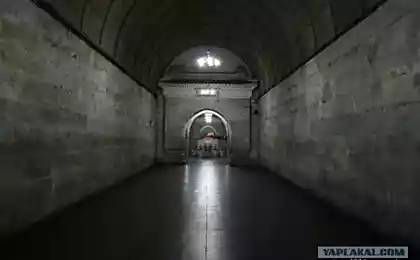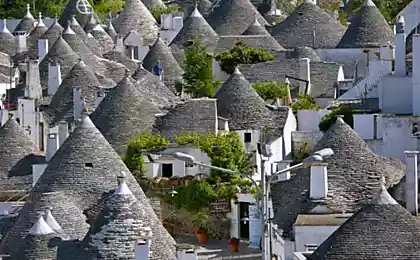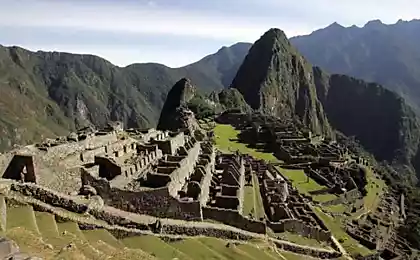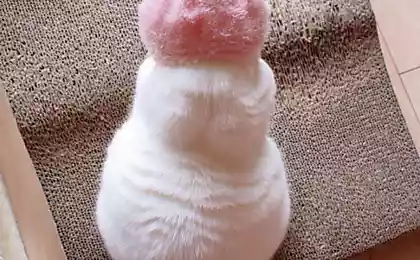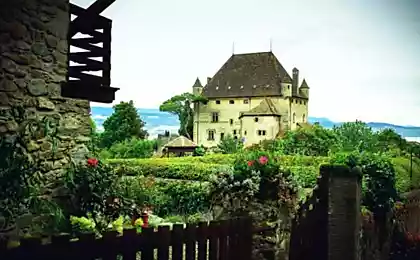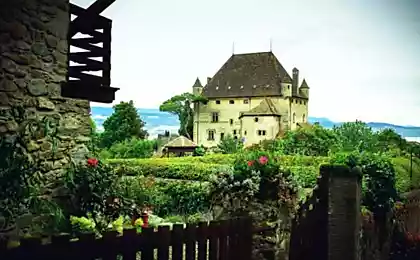586
Houses with conical roofs of the Trulli, Alberobello
Alberobello (Alberobello) – the capital of "Trulli"
Passing numerous olive groves, fruit orchards and vineyards along the road Strada dei Trulli (car maps it is labeled as the SS172), you will fall in absolutely fabulous, the white town of Alberobello, unique in its strangeness and beauty.


Alberobello is one of the most popular tourist destinations in Apulia (Puglia), with the 1,000 Trulli, recognized as a UNESCO world heritage site. Trulli (trulli) is a quaint round buildings with vaulted ceilings and a conical roof, formed by the method of "dry masonry" (i.e., without use of any binder solution) of rough-hewn blocks of limestone, collected from the local fields.
The walls are usually whitewashed Trulli and stone tiles on the roofs of houses are often painted religious or astrological symbols. Such symbols can be stars, hearts, crescents, crosses, etc. On roofs is often possible to see different patterns that also had a special symbolism.
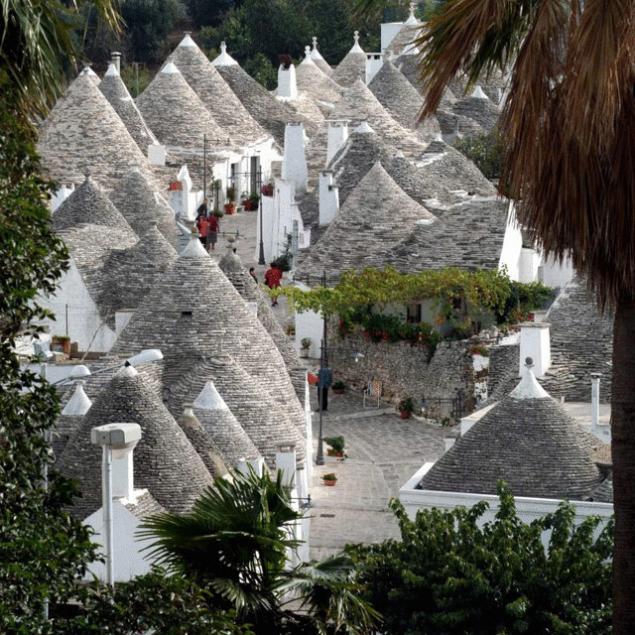
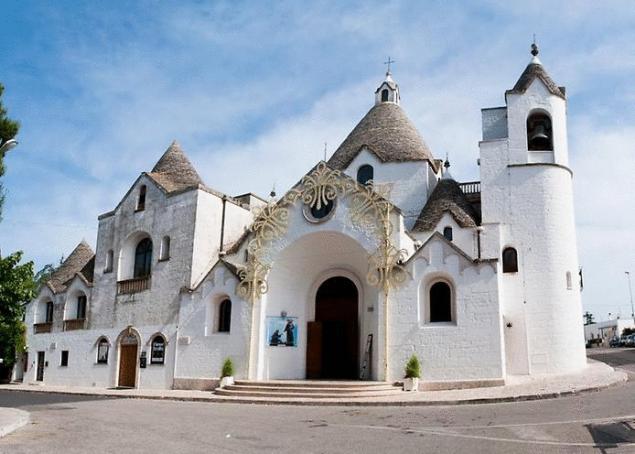
The origin of the Trulli is unclear, but this is usually called round ancient Roman tombs in the countryside. There is another version, according to which their name is derived from the Latin word "trulla" which means dome.
The history of the Trulli and Alberobello capital originates in the XV century, when by order of the king of Naples, Ferdinand of Aragon, the land was transferred to the family of Acquaviva from Conversano for the suffering he endured in the war against Turkey. Under the rule of count Andrea Matteo d' Acquaviva began the secret construction of the town of Alberobello, because the count, in fact, been violated at the time the Royal decree according to which for each new urban settlement was necessary to obtain Royal permission and with each more or less significant buildings — to pay a lot of tax KazNAU.
To develop as a city, Alberobello only started in 1635 thanks to the count Giangirolamo, named "cross-eyed Puglie". The count wanted to create a fiefdom, independent from the Aragonese court of Naples, and was therefore interested in increasing the population and construction of urban settlements. And not to pay the Royal taxes for the construction of new homes, he ordered his subjects that the house was built in the dry way, using only stone without lime and other binding materials. In the case of a Royal inspection, these structures were represented as temporary, that could easily be destroyed. Using three horses, directed in different directions, removed the stone at the base of the roof, which kept the entire house, and instead of the structure was a pile of stones. After the Royal inspection was left, Trulli is also easy enough recovered...

Only in Puglia about 20 thousand Trullo, there are special maps showing all existing structures. The first Trullo was built in 1635, and in 1925 a law was passed to halt construction of these homes.
The most interesting part of the trolls undoubtedly are a strange roof-dome. The roofs of the Trulli were built of two layers: the inner layer were laid of limestone blocks and the external limestone plates. This design prevents the penetration of water into the home. As a rule, the roof of a Trullo consists of several cones. Once Trulli rooftops were white, but over time changed color and darkened. The domes of the Trulli are male and female. The "males" there are domes,"pinnacolo". Before the building of domes learned that the master had built the house.
The walls of the Trulli are around 1 meter in width and it creates a comfortable atmosphere inside the house. Inside the Trulli in the winter is rather mild and summer is cool. In most cases, inside the Trullo there is a Central room with additional space in the form of niches. Three bedroom Trullo has multiple roofs of cones, each of which is placed a private room. Many Trulli are protected by UNESCO, the oldest of them belong to the 16th century.
Almost all of the Trulli are in private ownership, and, accordingly, are bought and sold.
The price of Trull depends on the condition and location and ranges from 5 to 30 thousand euros.
In the form of Trulli built and the Church of St. Antonio (1926-27. buildings) located in the district of Rione Monti.
Every year millions of tourists come to this fabulous city to wander through its narrow streets...
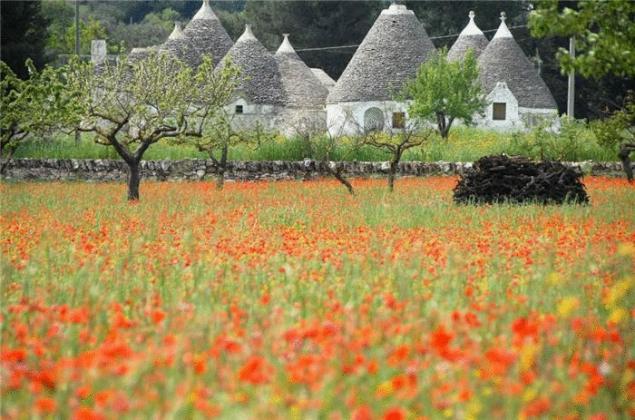
Source: /users/78
Passing numerous olive groves, fruit orchards and vineyards along the road Strada dei Trulli (car maps it is labeled as the SS172), you will fall in absolutely fabulous, the white town of Alberobello, unique in its strangeness and beauty.


Alberobello is one of the most popular tourist destinations in Apulia (Puglia), with the 1,000 Trulli, recognized as a UNESCO world heritage site. Trulli (trulli) is a quaint round buildings with vaulted ceilings and a conical roof, formed by the method of "dry masonry" (i.e., without use of any binder solution) of rough-hewn blocks of limestone, collected from the local fields.
The walls are usually whitewashed Trulli and stone tiles on the roofs of houses are often painted religious or astrological symbols. Such symbols can be stars, hearts, crescents, crosses, etc. On roofs is often possible to see different patterns that also had a special symbolism.


The origin of the Trulli is unclear, but this is usually called round ancient Roman tombs in the countryside. There is another version, according to which their name is derived from the Latin word "trulla" which means dome.
The history of the Trulli and Alberobello capital originates in the XV century, when by order of the king of Naples, Ferdinand of Aragon, the land was transferred to the family of Acquaviva from Conversano for the suffering he endured in the war against Turkey. Under the rule of count Andrea Matteo d' Acquaviva began the secret construction of the town of Alberobello, because the count, in fact, been violated at the time the Royal decree according to which for each new urban settlement was necessary to obtain Royal permission and with each more or less significant buildings — to pay a lot of tax KazNAU.
To develop as a city, Alberobello only started in 1635 thanks to the count Giangirolamo, named "cross-eyed Puglie". The count wanted to create a fiefdom, independent from the Aragonese court of Naples, and was therefore interested in increasing the population and construction of urban settlements. And not to pay the Royal taxes for the construction of new homes, he ordered his subjects that the house was built in the dry way, using only stone without lime and other binding materials. In the case of a Royal inspection, these structures were represented as temporary, that could easily be destroyed. Using three horses, directed in different directions, removed the stone at the base of the roof, which kept the entire house, and instead of the structure was a pile of stones. After the Royal inspection was left, Trulli is also easy enough recovered...

Only in Puglia about 20 thousand Trullo, there are special maps showing all existing structures. The first Trullo was built in 1635, and in 1925 a law was passed to halt construction of these homes.
The most interesting part of the trolls undoubtedly are a strange roof-dome. The roofs of the Trulli were built of two layers: the inner layer were laid of limestone blocks and the external limestone plates. This design prevents the penetration of water into the home. As a rule, the roof of a Trullo consists of several cones. Once Trulli rooftops were white, but over time changed color and darkened. The domes of the Trulli are male and female. The "males" there are domes,"pinnacolo". Before the building of domes learned that the master had built the house.
The walls of the Trulli are around 1 meter in width and it creates a comfortable atmosphere inside the house. Inside the Trulli in the winter is rather mild and summer is cool. In most cases, inside the Trullo there is a Central room with additional space in the form of niches. Three bedroom Trullo has multiple roofs of cones, each of which is placed a private room. Many Trulli are protected by UNESCO, the oldest of them belong to the 16th century.
Almost all of the Trulli are in private ownership, and, accordingly, are bought and sold.
The price of Trull depends on the condition and location and ranges from 5 to 30 thousand euros.
In the form of Trulli built and the Church of St. Antonio (1926-27. buildings) located in the district of Rione Monti.
Every year millions of tourists come to this fabulous city to wander through its narrow streets...

Source: /users/78
